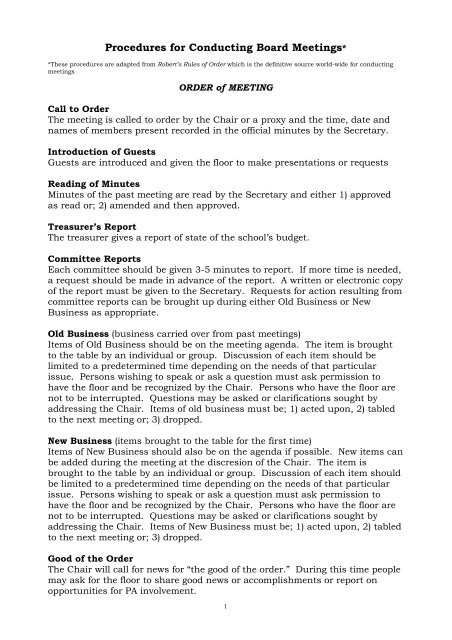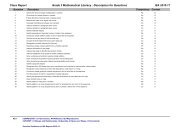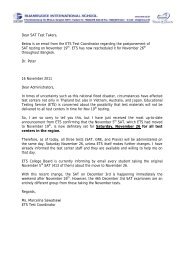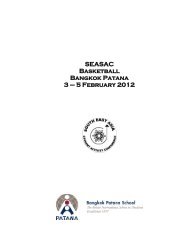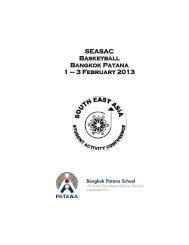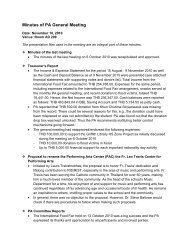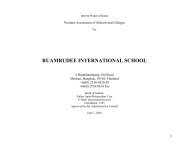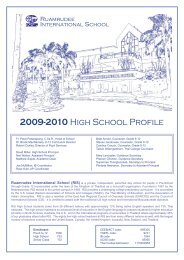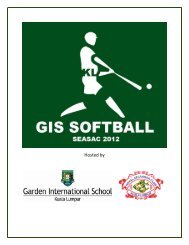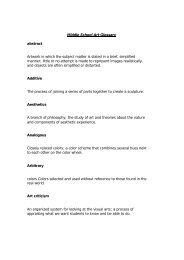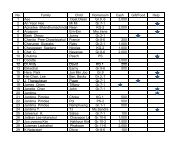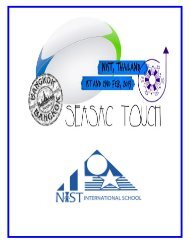Procedures for Conducting Board Meetings*
Procedures for Conducting Board Meetings*
Procedures for Conducting Board Meetings*
Create successful ePaper yourself
Turn your PDF publications into a flip-book with our unique Google optimized e-Paper software.
<strong>Procedures</strong> <strong>for</strong> <strong>Conducting</strong> <strong>Board</strong> <strong>Meetings*</strong><br />
*These procedures are adapted from Robert’s Rules of Order which is the definitive source world-wide <strong>for</strong> conducting<br />
meetings<br />
ORDER of MEETING<br />
Call to Order<br />
The meeting is called to order by the Chair or a proxy and the time, date and<br />
names of members present recorded in the official minutes by the Secretary.<br />
Introduction of Guests<br />
Guests are introduced and given the floor to make presentations or requests<br />
Reading of Minutes<br />
Minutes of the past meeting are read by the Secretary and either 1) approved<br />
as read or; 2) amended and then approved.<br />
Treasurer’s Report<br />
The treasurer gives a report of state of the school’s budget.<br />
Committee Reports<br />
Each committee should be given 3-5 minutes to report. If more time is needed,<br />
a request should be made in advance of the report. A written or electronic copy<br />
of the report must be given to the Secretary. Requests <strong>for</strong> action resulting from<br />
committee reports can be brought up during either Old Business or New<br />
Business as appropriate.<br />
Old Business (business carried over from past meetings)<br />
Items of Old Business should be on the meeting agenda. The item is brought<br />
to the table by an individual or group. Discussion of each item should be<br />
limited to a predetermined time depending on the needs of that particular<br />
issue. Persons wishing to speak or ask a question must ask permission to<br />
have the floor and be recognized by the Chair. Persons who have the floor are<br />
not to be interrupted. Questions may be asked or clarifications sought by<br />
addressing the Chair. Items of old business must be; 1) acted upon, 2) tabled<br />
to the next meeting or; 3) dropped.<br />
New Business (items brought to the table <strong>for</strong> the first time)<br />
Items of New Business should also be on the agenda if possible. New items can<br />
be added during the meeting at the discresion of the Chair. The item is<br />
brought to the table by an individual or group. Discussion of each item should<br />
be limited to a predetermined time depending on the needs of that particular<br />
issue. Persons wishing to speak or ask a question must ask permission to<br />
have the floor and be recognized by the Chair. Persons who have the floor are<br />
not to be interrupted. Questions may be asked or clarifications sought by<br />
addressing the Chair. Items of New Business must be; 1) acted upon, 2) tabled<br />
to the next meeting or; 3) dropped.<br />
Good of the Order<br />
The Chair will call <strong>for</strong> news <strong>for</strong> “the good of the order.” During this time people<br />
may ask <strong>for</strong> the floor to share good news or accomplishments or report on<br />
opportunities <strong>for</strong> PA involvement.<br />
1
Meeting Adjourned<br />
The Chair will adjourn the meeting and the Secretary will record the time in the<br />
minutes.<br />
Glossary of Terms<br />
Motions<br />
Motions are requests <strong>for</strong> action made by someone in the meeting. When a<br />
person requests a motion it must be seconded by another individual or it dies<br />
from lack of support. All motions must be stated clearly, recorded and<br />
repeated by the Secretary to assure clarity and accuracy. The Secretary must<br />
also record the name of the person making both the motion and the second.<br />
There are four types of motions:<br />
• Motion to Vote: This is a request to stop discussion and bring the agenda<br />
item to an immediate vote of the membership.<br />
• Motion to Table: This is a request to postpone the issue until a later time.<br />
The motion must specify an action to be taken and a time frame.<br />
• Motion to Drop: This is a request to stop discussing the item and drop it<br />
from further consideration.<br />
• Motion to Amend: Amendments may be added to a motion by the person<br />
making the original motion or with his/her agreement. This can be done<br />
to make the wording more suitable, to clarify the intent or to add relevant<br />
content.<br />
Call <strong>for</strong> the Vote<br />
When someone calls <strong>for</strong> the vote it officially ends discussion. The Chair then<br />
decides if a voice vote or hand vote is appropriate. In the case of a voice vote<br />
the Chair will say; “all in favor” to which the members will respond by saying;<br />
“Aye” he/she will then say; “all opposed” to which the members will respond;<br />
“Aye” In the case of a hand vote, the Chair counts the votes <strong>for</strong> and against<br />
and the Secretary records the outcome.<br />
Chair<br />
The Chair is the person who runs the meeting, usually the President, or in the<br />
case of his/her absence, the next person in line such as the Vice-President.<br />
Secretary<br />
The Secretary is responsible to record accurate and thorough transcription of<br />
meetings, distribute agendas and minutes to the membership and be in charge<br />
of official correspondence.<br />
Treasurer<br />
The treasurer is responsible <strong>for</strong> recording and handling all financial<br />
transactions of the organization, accounting <strong>for</strong> budgetary process and<br />
reporting to the organization at every meeting.<br />
2


